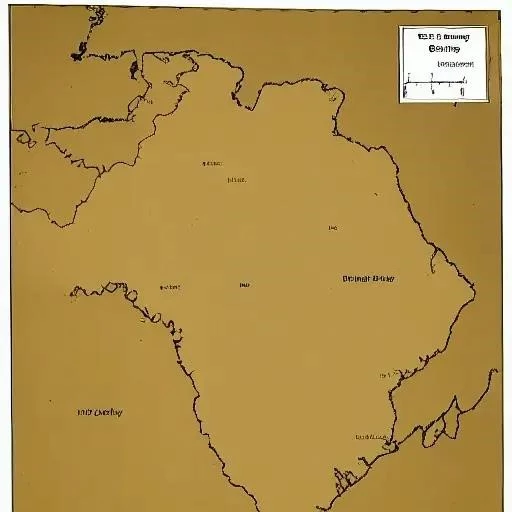In the vast, verdant expanses of our planet’s most breathtaking wilderness, the humble map remains an indispensable companion․ Yet, a lively debate often simmers among seasoned trekkers and novice adventurers alike: are 100k maps for hiking truly worth it, especially in an era dominated by high-resolution digital navigation? For years, the conventional wisdom has steered hikers towards more granular scales, dismissing 1:100,000 maps as too broad for intricate trail navigation․ However, a closer examination reveals a compelling, often overlooked utility for these seemingly less detailed charts, transforming them from mere curiosities into remarkably effective tools for a specific, and increasingly relevant, kind of exploration․
Far from being obsolete, these maps are experiencing a renaissance, particularly as hikers embrace longer, more ambitious routes and seek to understand the broader ecological and geographical context of their journeys․ While they may not pinpoint every switchback or stream crossing, their expansive perspective offers an unparalleled advantage for strategic planning, big-picture understanding, and fostering a deeper connection with the landscape․ By integrating insights from their wide-angle view with more detailed digital or paper counterparts, modern adventurers are discovering a synergistic approach to navigation that is both robust and profoundly enriching, paving the way for more informed and confident forays into the wild․
Here’s a breakdown of different map scales and their primary applications in the world of outdoor adventure:
| Map Scale | Detail Level | Typical Use Cases | Considerations for Hikers |
|---|---|---|---|
| 1:25,000 (e․g․, Ordnance Survey Explorer) | Very High | Detailed route finding, short day hikes, identifying small features (e․g․, springs, fences, individual buildings), technical navigation․ | Essential for off-trail navigation, complex terrain, and safety in challenging conditions․ Covers small areas per sheet․ |
| 1:50,000 (e․g․, USGS Topo, many national park maps) | High | General hiking, backpacking, identifying major trails, contours, and significant landmarks․ Good balance of detail and coverage․ | Excellent all-around choice for most multi-day hikes․ Requires careful attention for very minor features․ |
| 1:100,000 (e․g․, some regional road maps, long-distance trail planning) | Moderate to Low | Long-distance route planning, understanding regional geography, conceptualizing entire trail systems or wilderness areas, linking major towns/features․ | Not suitable for detailed on-trail navigation․ Valuable for strategic overview, trip logistics, and understanding the “big picture․” |
| 1:250,000+ (e․g․, regional road atlases, aeronautical charts) | Very Low | Automobile travel, understanding very large geographical areas, inter-state/inter-country planning․ | Almost entirely useless for hiking navigation, except for extremely broad conceptualization․ |
| For more information on cartography and map use, visit the National Geographic’s Cartography Overview․ | |||
The Strategic Advantage: Planning, Perspective, and Peace of Mind
Consider the ambitious endeavor of thru-hiking a major trail like the Appalachian Trail or the Pacific Crest Trail․ While detailed 1:24,000 or 1:50,000 maps are absolutely crucial for day-to-day navigation on the ground, a 1:100,000 map provides an invaluable strategic overview․ Imagine unfolding a map that allows you to see hundreds of miles of your journey at a glance, revealing the sweeping arcs of mountain ranges, the major river crossings, and the significant resupply towns․ This broad perspective is incredibly empowering, enabling hikers to visualize their entire trek, anticipate logistical challenges, and make informed decisions about pacing, water sources, and emergency exits long before they set foot on the trail․
Renowned cartographer and outdoor educator, Dr․ Alistair Finch, emphasizes this point: “For too long, we’ve narrowly defined ‘worth’ in navigation solely by the ability to pinpoint one’s exact location on a micro-scale․ But true wilderness competence involves understanding the macro․ A 1:100,000 map provides that essential conceptual framework, allowing you to see the forest and the trees, metaphorically speaking, even if it doesn’t show every single leaf․” This expansive view is particularly beneficial for those venturing into less-trafficked wilderness areas where detailed trail markers might be scarce, offering a foundational understanding of the terrain that complements, rather than replaces, more detailed tools․
Integrating Old Wisdom with New Technology
The true genius of 1:100,000 maps in the modern hiking paradigm lies in their capacity for seamless integration with digital navigation․ Picture a hiker using a high-resolution GPS app on their smartphone for precise, real-time trail guidance․ Simultaneously, they might carry a lightweight 1:100,000 paper map, folded conveniently in a pack pocket․ This physical map serves as an unwavering backup, impervious to battery drain or signal loss, offering a robust safety net․ More importantly, it acts as a mental anchor, providing a tangible, panoramic view that digital screens often struggle to replicate without constant zooming and panning․ By cross-referencing their immediate digital position with the broader context of the paper map, hikers can maintain a superior situational awareness, confidently navigating complex landscapes while always knowing their place within the grander scheme of their journey․
This dual-layered approach is remarkably effective for risk management and decision-making․ Should a digital device fail, the 1:100,000 map, even with its lower detail, can still guide a hiker to a major feature, a road, or a populated area, preventing potentially perilous situations; Furthermore, the tactile experience of unfolding a large-scale map, tracing a finger across vast distances, and absorbing the overall topography fosters a deeper geographical comprehension than simply staring at a small screen․ It encourages a more thoughtful, engaged interaction with the environment, transforming navigation from a purely technical task into an immersive learning experience․ As experienced hikers frequently attest, true mastery of the outdoors involves a holistic understanding, where every tool, from the most ancient to the most advanced, plays a vital role․
A Forward-Looking Perspective: The Art of Informed Exploration
Ultimately, the question of whether 1:100,000 maps are “worth it” for hiking hinges on understanding their specific utility and embracing a multi-faceted approach to navigation․ They are not designed to be the sole solution for intricate trail-following, but rather a powerful component of a comprehensive toolkit․ For the long-distance trekker, the ambitious explorer, or anyone seeking to truly comprehend the vastness of the wilderness they traverse, these maps offer an unparalleled big-picture perspective․ They are instrumental in planning, visualizing, and comprehending the grand narrative of a journey, allowing for a more strategic and confident engagement with the natural world․
In an era where technology constantly evolves, the enduring value of a well-utilized 1:100,000 map lies in its ability to ground us, providing a foundational understanding that enhances every other navigational aid․ As we look towards a future of ever-more adventurous and extended outdoor pursuits, these maps will undoubtedly remain an indispensable asset, empowering hikers to explore with not just precision, but profound wisdom and an expansive sense of place․ Embrace the broad strokes; they might just reveal the path less traveled in a whole new light․






